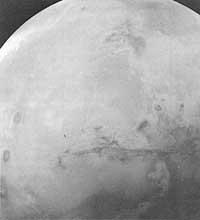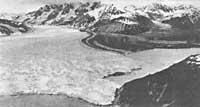Martitz had seas and atmosphere
1993/06/01 Elhuyar Zientzia Iturria: Elhuyar aldizkaria
Neither the astronomical observations nor the data sent in 1979 by the probe “Viking” have suggested that in his day Mars presented heat and its seas and continents, but, however, that is the idea defended by Victor Baker, Robert Strom and his collaborators of the University of Arizona in North America, despite having raised numerous powders among astronomers of the world.
In order to better judge this brave theory, we will say that today the climate of Mars is similar to that of our stratosphere. The average temperature is 50ºC and the pressure is 10 millibar.

According to the data sent by the probe “Viking”, three billion years ago there were catastrophic floods and became famous channels by erosion. Likewise, it is estimated that for this purpose, flows of 1,000 million m3/s were needed for every 10 million euros. But what happened to that water? It was stacked in buried layers, frozen forever. Due to tectonic pressures, at one time (although we do not know when it was accurate) this water reemerged forming a large lake. The lake was three times larger than the Caspian, but then the water evaporated or froze.
For Baker and his companions that is true, but not the whole truth. Astronomical observations indicate the existence of sedimentary zones in reliefs similar to the islands and coasts. In craters created by the impact of meteorites, remains similar to marine erosion are observed.
In addition, recent studies show that in the south of Mars there is a banquisa similar to that of our planet. The reliefs also suggest that they have been similar to our glaciers.
But if there is glacier, there is also water stream. This water would evaporate again and cool into snow, feeding the glacier again. However, in order for the thesis of these American astronomers to be credible, on Mars there should be warmer climates than the current ones so that the water would have a cycle similar to that of Earth.
The mild climate could be on Mars thanks to volcanoes. On the one hand, they were quite hot to melt the ice, and on the other, they released enough carbon gases to produce the greenhouse effect.
However, it could not have happened so only once the reliefs that are observed today and you have to think that the oceans of Mars were periodic (repeated).
But “orthodox” astrophysicists disagree. In fact, for such episodes to be true, volcanoes had to shed huge amounts of gas.
However, in August of this year the Observer probe will offer us many details about this hypothesis and we will be able to know if the waves shaped the coasts of Martitz at intervals of millions of years.

Gai honi buruzko eduki gehiago
Elhuyarrek garatutako teknologia





